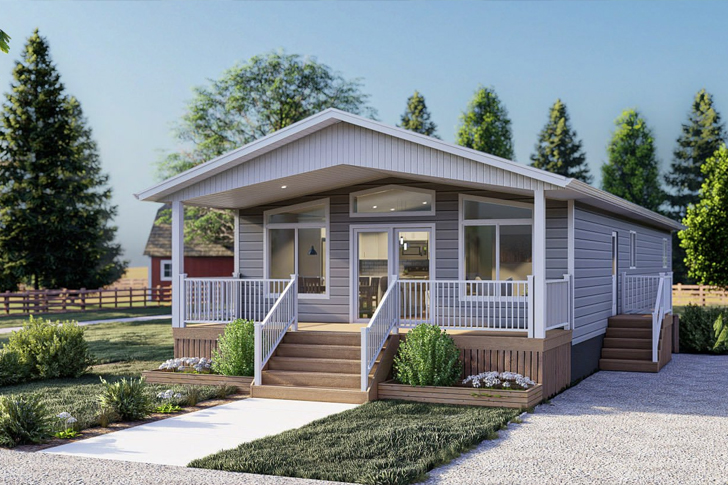Prefab Homes: A Practical Option for Elderly Downsizing
As the baby boomer generation reaches retirement age, many are considering downsizing to more manageable living arrangements. Prefab homes, also known as prefabricated or modular homes, are becoming an increasingly popular option due to their affordability, efficiency, and adaptability. This article explores why prefab homes are a practical solution for elderly individuals looking to downsize, backed by facts and figures.

Understanding Prefab Homes
Prefabricated homes are houses constructed in sections at a factory and then transported to a building site where they are assembled. This mode of construction offers significant advantages in terms of quality control, time savings, and potentially lower costs. According to a report by the U.S. Census Bureau, the average cost per square foot for a prefab home was approximately $111, compared to $150 for traditional site-built homes, showcasing the potential cost savings prefab offers.
The Financial Benefits of Prefab Homes for Seniors
For many in their retirement years, financial security is paramount. Prefab homes present a less expensive option not just in construction costs but also in ongoing maintenance. Energy efficiency is a standard feature in most new prefab designs, incorporating better insulation, advanced window options, and sometimes renewable energy sources like solar panels. This can significantly reduce utility bills, a major advantage for those on fixed incomes. Additionally, the Manufactured Housing Institute highlights that prefab homes can be up to 35% cheaper per square foot compared to traditional housing options.
Speed of Construction
Another significant benefit of prefab homes, particularly important for the elderly, is the speed of construction. Traditional homes typically take anywhere from six months to a year or more to complete, while a prefab home can be built in a fraction of that time. In fact, the Building Systems Network indicates that prefab homes can be assembled in as little as three days to a few weeks after being delivered to the site. This swift build time allows seniors to transition more seamlessly into their new homes without the lengthy disruptions associated with traditional construction processes.
Customization and Accessibility
Modern prefab homes offer extensive customization options, essential for seniors requiring specific accessibility adaptations. Features such as wider doorways, single-floor layouts, walk-in showers, and support bars can all be easily incorporated. This adaptability ensures that elderly individuals can have a living space tailored to their mobility requirements and personal taste. Ryan Smith, a professor in the School of Design and Construction at Washington State University, confirms that one of the major benefits of modular construction is its intrinsic ability to alter designs to meet individual needs relatively inexpensively.
Reduced Environmental Impact
With a growing global emphasis on sustainability, prefab homes offer an environmentally friendly alternative to traditional construction methods. A study from the Journal of Construction Engineering and Management noted that prefab construction could reduce construction waste by up to 10 times compared to standard construction practices. For seniors looking to minimize their ecological footprint, this is a compelling factor. Furthermore, factories optimized for modular construction significantly reduce on-site waste and are better able to recycle materials, aligning with the values of environmentally conscious seniors.
Safety Considerations
Prefabricated homes are built to adhere to strict national regulations according to the U.S. Department of Housing and Urban Development as well as local building codes. The controlled factory environment in which they are constructed also reduces the chances of defects like mold and mildew, common concerns in traditional building processes that can pose health risks, especially to the elderly. Furthermore, the strong framing and secure fastenings used in prefab buildings can offer superior resistance to natural disasters such as hurricanes and earthquakes, providing extra peace of mind for the occupants.
Community and Support
Many prefab home manufacturers also offer placement in specially designed communities that cater to senior living, providing communal spaces and activities designed to encourage social interaction and promote a sense of belonging. This community aspect can be very beneficial for seniors looking to maintain an active and social lifestyle. Such environments not only offer opportunities for recreation and social engagement but also often include support services geared towards the needs of older adults, maximizing their independence while providing access to care as needed.
Conclusion
Prefab homes represent a comprehensive solution for many seniors considering downsizing. They offer financial savings, quicker build times, customizable layouts that prioritize safety and accessibility, environmental sustainability, and opportunities for community involvement. As the demand for affordable, efficient, and adaptable housing continues to grow with the aging population, prefab homes stand out as a robust option that addresses the diverse needs of the elderly looking for a place to call home in their later years.
For those contemplating a simpler, tailored living situation that aligns with a comfortable retirement, prefab homes are deserving of serious consideration. Whether prioritizing budget, customization, or community, these modern constructions are proving to be a wise choice for seniors navigating the next stage of their life journey.







Recent Comments